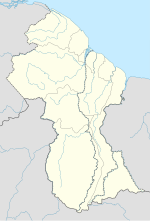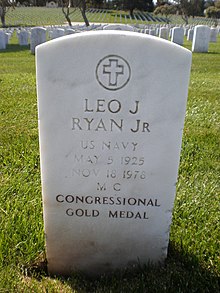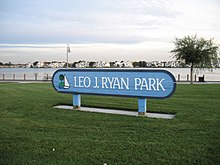Leo Ryan
| Leo Joseph Ryan, Jr. | |
 Ryan in 1977–1978 | |
| In office January 3, 1973 – November 18, 1978 | |
| Preceded by | Paul N. McCloskey, Jr. |
|---|---|
| Succeeded by | William H. Royer |
| Constituency | 11th District |
Member of the California State Assembly for the 27th District | |
| In office 1962–1972 | |
| Preceded by | Glenn E. Coolidge |
| Succeeded by | Lou Papan |
| Constituency | 27th District |
Mayor of South San Francisco, California | |
| In office 1962–1962 | |
| Constituency | South San Francisco, California |
| Born | May 5, 1925 Lincoln, Nebraska |
| Died | November 18, 1978 (aged 53) Port Kaituma, Guyana |
| Political party | Democratic |
| Children | Five |
| Occupation | Politician |
Ryan was also famous for vocal criticism of the lack of Congressional oversight of the Central Intelligence Agency (CIA), and authored the Hughes-Ryan Amendment, passed in 1974. He was also an early critic of L. Ron Hubbard and his Scientology movement and of the Unification Church of Sun Myung Moon.[1] On November 3, 1977, Ryan read into the United States Congressional Record a testimony by John Gordon Clark about the health hazards connected with destructive cults.[1] Ryan is the only U.S. congressman ever to be killed in the line of duty.[2][3][4][5] He was posthumously awarded the Congressional Gold Medal in 1983.
Contents[show] |
[edit] Early life and career
Leo Ryan was born in Lincoln, Nebraska.[6] Throughout his early life, his family moved frequently through Illinois, Florida, New York, Wisconsin, and Massachusetts. He graduated from Campion Jesuit High School in Prairie du Chien, Wisconsin in 1943.[7][8] He then received V-12 officer training at Bates College and served with the United States Navy from 1943 to 1946 as a submariner.[9]Ryan graduated from Nebraska's Creighton University with an B.A. in 1949 and an M.S. in 1951.[6] He taught History at Capuchino High School, and chaperoned the marching band in 1961 to Washington, D.C. to participate in President John F. Kennedy's inaugural parade. Ryan was inspired by Kennedy's call to service in his inaugural address, and decided to run for higher office.[10] He served as a teacher, school administrator and South San Francisco city councilman from 1956 to 1962.[6]
[edit] Political career
[edit] State of California
In 1962, Ryan was elected mayor of South San Francisco. He served less than a year as mayor, before taking a seat in the California State Assembly's 27th district, winning his assembly race by a margin of 20,000 votes.[10][11] He had previously run for the State Assembly's 25th district in 1958, but lost to Republican Louis Francis.[11] Ryan served as a delegate to the Democratic National Convention in 1964 and 1968,[6] and he held his Assembly seat through 1972, when he was elected to the United States House of Representatives. He was successively elected three more times to the United States Congress.[6]U.S. Congresswoman and former California State Senator Jackie Speier described Ryan's style of investigation as "experiential legislating".[10] After the Watts Riots of 1965, Assemblyman Ryan went to the area and took a job as a substitute school teacher to investigate and document conditions in the area. In 1970, using a pseudonym, Ryan had himself arrested, detained, and strip searched to investigate conditions in the California prison system. He stayed as an inmate for ten days in the Folsom Prison, while presiding as chairman on the Assembly committee that oversaw prison reform.[12][13]
As a California Assemblyman, Ryan also served as the Chairman of legislative subcommittee hearings and presided over hearings involving his later successor as Congressman, Tom Lantos.[14] Ryan pushed through important educational policies in California and authored what came to be known as the Ryan Act, which established an independent regulatory commission to monitor educational credentialing in the state.[15]
[edit] United States Congress
During his time in Congress, Ryan went to Newfoundland with James Jeffords to investigate the inhumane killing of seals,[16][17] and he was famous for vocal criticism of the lack of Congressional oversight of the Central Intelligence Agency (CIA), authoring the Hughes-Ryan Amendment,[18][19] which would have required extensive CIA notification of Congress about planned covert operations.[20][21] Congressman Ryan once told Dick Cheney that leaking a state secret was an appropriate way for a member of Congress to block an "ill-conceived operation".[22]Ryan criticized L. Ron Hubbard's Scientology movement and the Unification Church of Sun Myung Moon. On November 3, 1977, Ryan read into the United States Congressional Record a testimony by John Gordon Clark about the health hazards connected with destructive cults.[1] In this speech before Congress, Congressman Ryan noted that his greatest concern was: "for those young people who have been converted by these religious cults and for their parents, who have suffered the loss of their children."[1] Congressman Ryan went on to note that a parent of one of these young people had first brought Dr. Clark's testimony to his attention.[1] In previous correspondence with this parent, Congressman Ryan thanked the parent for her "detailed letter regarding Scientology", and yet noted that "We haven't yet found a way to attack these jackals who feed on children and young adults who are too emotionally weak to stand by themselves when they reach the age of consent."[23] Congressman Ryan supported Patricia Hearst, and along with Senator S. I. Hayakawa, delivered Hearst's application for a presidential commutation to the Pardon Attorney.[24]
[edit] Peoples Temple
In 1978, reports regarding widespread abuse and human rights violations in Jonestown among the Peoples Temple, led by cult leader Jim Jones, began to filter out of the organization's Guyana enclaves. Ryan was friends with the father of former Temple Member Bob Houston, whose mutilated body was found near train tracks on October 5, 1976, three days after a taped telephone conversation with Houston's ex-wife in which leaving the Temple was discussed.[25] Ryan's interest was further aroused by the custody battle between the leader of a "Concerned Relatives" group, Timothy Stoen, and Jones following a Congressional "white paper" written by Stoen detailing the events.[26][27] Ryan was one of 91 Congressmen to write Guyanese Prime Minister Forbes Burnham on Stoen's behalf.[25][26]After later reading an article in the San Francisco Examiner, Ryan declared his intention to go to Jonestown, an agricultural commune in Guyana where Jim Jones and roughly 1,000 Temple members resided. Ryan's choice was also influenced both by the Concerned Relatives group, which consisted primarily of Californians, as were most Temple members, and by his own characteristic distaste for social injustice.[28] According to the San Francisco Chronicle, while investigating the events, the United States Department of State "repeatedly stonewalled Ryan's attempts to find out what was going on in Jonestown", and told him that "everything was fine".[10] The State Department characterized possible action by the United States government in Guyana against Jonestown as creating a potential "legal controversy", but Ryan at least partially rejected this viewpoint.[29] In a later article in The Chronicle, Ryan was described as having "bucked the local Democratic establishment and the Jimmy Carter administration's State Department" in order to prepare for his own investigation.[13]
[edit] Travels to Jonestown
On November 1, 1978, Ryan announced that he would visit Jonestown.[30] He did so as part of a government investigation and received permission and government funds to do so.[31] He made the journey in his role as chairman of a congressional subcommittee with jurisdiction over U.S. citizens living in foreign countries. He asked the other members of his Bay Area congressional delegation to join him on the investigation to Jonestown, but they all declined his invitation.[10] Ryan had also asked his friend Indiana Congressman Dan Quayle to accompany him – Quayle had served with Ryan on the Government Operations Committee – but Quayle was unable to go on the trip.[32]While the party was initially planned to consist of only a few members of the Congressman's staff and press as part of the congressional delegation, once the media learned of the trip the entourage ballooned to include, among others, Concerned Relatives members. Congressman Ryan traveled to Jonestown with 17 Bay Area relatives of Peoples Temple members, several newspaper reporters and an NBC TV team.[33] When the legal counsel for Jones attempted to impose several restrictive conditions on the visit, Ryan responded that he would be traveling to Jonestown whether Jones permitted it or not. Ryan's stated position was that a "settlement deep in the bush might be reasonably run on authoritarian lines".[33] However, residents of the settlement must be allowed to come and go as they pleased. He further asserted that if the situation had become "a gulag", he would do everything he could to "free the captives".[33]
[edit] Jungle ambush
That night the delegation stayed at a local hotel where, despite confirmed reservations, most of the rooms had been cancelled and reassigned, leaving the delegation sleeping in the lobby.[36] For three days, Ryan continued negotiation with Jones's legal counsel and held perfunctory meetings with embassy personnel and Guyanese officials.[37]
While in Georgetown, Ryan visited the Temple's Georgetown headquarters in the suburb of Lamaha Gardens.[38] Ryan asked to speak to Jones by radio, but Sharon Amos, the highest-ranking Temple member present, told Ryan that he could not because his present visit was unscheduled.[35] On November 17, Ryan's aide Jackie Speier (who became a Congresswoman in April 2008), the United States embassy Deputy Chief of Mission Richard Dwyer, a Guyanese Ministry of Information officer, nine journalists, and four Concerned Relatives representatives of the delegation boarded a small plane for the flight to an airfield at Port Kaituma a few miles outside of Jonestown.[34] At first, only the Temple legal counsel was allowed off the plane, but eventually the entire entourage (including Gordon Lindsay, reporting for NBC) was allowed in. Initially, the welcome at Jonestown was warm,[31] but Temple member Vernon Gosney handed a note to NBC correspondent Don Harris which stated, "Please help me get out of Jonestown," listing himself and Temple member Monica Bagby.[33] That night, the media and the delegation were returned to the airfield for accommodations following Jones's refusal to allow them to stay the night; the rest of the group remained.[34]
The next morning, Ryan, Speier, and Dwyer all continued their interviews, and in the morning met a woman who secretly expressed her wish to leave Jonestown with her family and another family. Around 11:00 A.M. local time, the media and the delegation returned and took part in interviewing Peoples Temple members. Around 3:00 p.m., 14 Temple defectors, and Larry Layton posing as a defector, boarded a truck and were taken to the airstrip, with Ryan wishing to stay another night to assist any others that wished to leave. Shortly thereafter, a failed knife attack on Congressman Ryan occurred while he was arbitrating a family dispute on leaving.[39] Against Ryan's protests, Deputy Chief of Mission Dwyer ordered Ryan to leave, but he promised to return later to address the dispute.[34]
The entire group left Jonestown and arrived at the Kaituma airstrip by 4:45 p.m. local time.[34] Their exit transport planes, a twin-engine Otter and a Cessna, did not arrive until 5:10 p.m.[34] The smaller six-seat Cessna was just taxiing to the end of the runway when one of its occupants, Larry Layton, opened fire on those inside, wounding several.[34] Concurrently, several other Peoples Temples members who had escorted the group out began to open fire on the transport plane, killing Congressman Ryan, three journalists and a defecting Temple member, while wounding nine others, including Speier.[25][40] The gunmen riddled Congressman Ryan's body with bullets before shooting him in the face.[41] The passengers on the Cessna subdued Larry Layton and the surviving people on both planes fled into nearby fields during and after the attack.[34]
That afternoon, before the news became public, the wife of Ryan aide William Holsinger received three threatening phone calls.[42] The caller allegedly stated, "Tell your husband that his meal ticket just had his brains blown out, and he better be careful."[42] The Holsingers then fled to Lake Tahoe and later to a ranch in Houston.[42] They never returned to San Francisco.[42] Following its takeoff, the Cessna radioed in a report of the attack, and the U.S. Ambassador, John R. Burke, went to the residence of Prime Minister Forbes Burnham.[34] It was not until the next morning that the Guyanese army could cut through the jungle and reach the settlement.[34] They discovered 909 of its inhabitants dead; the individuals died in what the United States House of Representatives described as a "mass suicide/murder ritual".[34]
[edit] Conviction of Larry Layton
Larry Layton, brother of author and former Peoples Temple member Deborah Layton, was convicted in 1986 of conspiracy in the murder of Leo Ryan.[43] Temple defectors boarding the truck to Port Kaituma warned about Larry Layton that "there's no way he's a defector. He's too close to Jones." [44] Layton was the only former Peoples Temple member to be tried in the United States for criminal acts relating to the murders at Jonestown.[45][46] He was convicted on four different murder-related counts.[47]On March 3, 1987, Layton was sentenced to concurrent sentences of life in prison for "aiding and abetting the murder of Congressman Leo Ryan", "conspiracy to murder an internationally protected person, Richard Dwyer, Deputy Chief of Mission for the United States in the Republic of Guyana", as well as fifteen years in prison on other related counts.[48] At that time, he would become eligible for parole in five years.[49] On June 3, 1987, Layton's motion to set aside the conviction "on the ground that he was denied the effective assistance of counsel during his second trial" was denied by the United States District Court, of the Northern District of California.[49] After spending eighteen years in prison, Layton was released from custody in April 2002.[50]
[edit] Memorial
[edit] Burial
Leo Ryan's body was returned to the United States and interred at Golden Gate National Cemetery in San Bruno, California. The official Congressional Memorial Services for Ryan were compiled into a book: Leo J. Ryan - Memorial Services - Held In The House Of Representatives & Senate Of The U. S., Together With Remarks.[51] Remembering the funeral of her brother held in the San Francisco area, Ryan's younger sister Shannon stated she was surprised both by the number of supporters that attended the funeral, and by the "outgrowth of real, honest sorrow".[3]For his efforts, Ryan was posthumously awarded a Congressional Gold Medal by the United States Congress and signed by President Ronald Reagan.[52][53][54] He is the first and only member of Congress to have been killed in the line of duty.[2][3][4][5] In President Reagan's remarks upon signing the bill awarding Congressman Ryan the Congressional Gold Medal, he stated: "It was typical of Leo Ryan's concern for his constituents that he would investigate personally the rumors of mistreatment in Jonestown that reportedly affected so many from his district."[52] Ryan's daughters Erin and Patricia had helped to garner support for the Congressional Gold Medal, in time for the fifth anniversary of Ryan's death.[55]
After his death, Ryan's daughter Shannon Jo changed her name to Jasmine and joined Bhagwan Shree Rajneesh, a cult,[31][56][57][58] while her sister Patricia became president of the old Cult Awareness Network.[59][60] Ryan's daughter Erin worked for the C.I.A. before eventually becoming an aide to her father's former aide Jackie Speier, who had in 1998 been elected to the California State Senate.[60]
[edit] Anniversary
For the 30th anniversary, Congresswoman Jackie Speier sponsored a bill to designate the facility of the United States Postal Service located at 210 South Ellsworth Avenue in San Mateo, California, as the "Leo J. Ryan Post Office Building".[63] President George W. Bush signed it into law on October 21, 2008.[64] On November 17, 2008, Jackie Speier spoke at the dedication ceremony at the post office. In part of her speech, she said, "There are those - still, thirty years after his passing - who question his motives, or the wisdom of his actions. But criticism was just fine with Leo. Leo Ryan never did anything because he thought it would make him popular. He was more interested in doing what he knew was right."[65]








